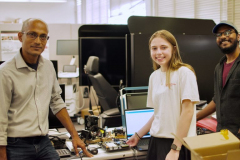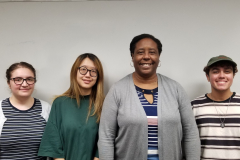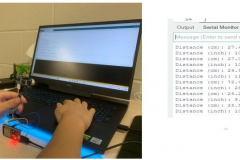Application for Summer 2024 Cohort is now open. Note that the program includes a stipend of $6000 as well as support to cover travel, lodging, and food. Please apply through this URL: https://etap.nsf.gov/award/631/opportunity/6634.
Welcome to the electronic home for the REU site on Secure, Accessible, and Sustainable Transportation. This page is intended to contain comprehensive information of the site, its objectives, the research problems targeted, and directions for application.
This page is divided into the following sections.
Congratulations to the amazing summer 2023 REU SAST Cohort!
Also, see an article on the REU in the Nelms Institute newsletter here.
Site Overview
Recent years are seeing a transformative and rapid push towards autonomy in the transportation systems, driven by explosive infusion of electronics, sensors, and software. Autonomous transportation holds out the promise of dramatically improving transportation system by reducing and eventually eliminating human errors and inefficiencies. However, it has resulted in new and challenging research questions on effective use of autonomy to achieve security, accessibility, and sustainability. Following are some representative challenges.
- How can the electronics and software in transportation systems be protected against cyber-attacks?
- How can autonomy cater to persons with disabilities that currently depend on a human operator for a variety of transportation needs?
- How can we trust autonomous transportation to operate safely?
- How can we exploit autonomy to minimize impact of transportation on our environment?
The REU site will support talented undergraduate students to perform high-impact research exploring these and other research questions and come up with novel solutions.
Additionally, REU participants will get trained in foundational research skills through hands-on projects, workshops and other trainings, and learn how to disseminate research results through oral and written communications.
Financial Support
Candidates accepted to the program will receive a stipend of $6000. Additionally, financial support will be provided to cover travel, lodging, and meals.
Application Procedure
Application is through NSF ETAP. Please apply through this URL: https://etap.nsf.gov/award/631/opportunity/6634. Please contact sandip@ece.ufl.edu if you have any questions.
Affiliated Faculty
The research is supervised by faculty members in the University of Florida, affiliated to the Department of Electrical and Computer Engineering, Warren B. Nelms Institute for Connected World, and University of Florida Transportation Institute.
|
|
||||||||||
|
|
|
|
Representative Projects
[Note: This list is provided to give a flavor of the research the students may expect to experience as part of the REU site activities. The actual research projects assigned to specific cohorts will depend on the interest of the faculty mentors at that time.]
Secure Cooperative Transportation Applications
A critical feature of emergent transportation systems is the ability of the constituent system components to coordinate and communicate. Vehicles in near future will communicate on road with other vehicles, with intersections, parking areas, even coffee shops. Connectivity is critical to efficiency and sustainability of emergent transportation. It is also a highly vulnerable feature that can be easily compromised through cyber-attacks. The projects below will explore the cyber-security challenges in cooperative transportation applications and their impact.
Secure, Resilient Platooning Autonomous Vehicular (CAV) platoon refers to a group of vehicles that coordinate their movements and operate as a single unit. The vehicle at the head acts as the leader of the platoon and determines the course of the vehicles following it. The follower vehicles utilize Vehicle-to-Vehicle (V2V) communication and automated driving support systems to automatically maintain a small fixed distance between each other. Reliance on V2V communication exposes platoons to several possible malicious attacks which can compromise the safety, stability, and efficiency of the vehicles. In this project, we will explore approaches for resilient platooning algorithms against V2V attacks. The idea is to combine physical features (e.g., continuity and spatio-temporal correlation) with ML-based resiliencies solutions that are robust against anomalous information. This project will include three synergistic explorations: (a) developing a comprehensive taxonomy of cyber-attacks to V2V communications; (b) developing robust ML-based algorithms to estimate and predict V2V anomalies; (c) exploring resiliency solutions to mitigate cyber-attacks at runtime.
Intersection Management under Adversarial Conditions Consider emergent smart intersections, where an intersection manager allocates (mutually exclusive) time slots to traffic that needs to cross the intersection. Emergent intersection managers will negotiate with oncoming traffic for intersection slots. The problem considered in this project is the impact of adversarial activities on this negotiation. Note that in addition to tampering the communication payload of the negotiating messages, adversarial activity for this application can arise from rogue vehicles or intersection managers, e.g., a rogue vehicle may “hog†an intersection by simply providing wrong or misleading information on the planned utilization of the intersection. In this project, we will consider this problem and explore solutions for robust intersection management against adversarial attacks. Several solutions will be explored, including (1) incentive-based solution, (2) game-theoretic approaches, and ((3) ML-based anomaly detection to identify suspicious communications.
AI-Based Accessible Transportation Infrastructure
Consider a person with disability who nevertheless would like to be independent in regular activities that require (public) transportation. In current (manual) transportation systems, the operator of the vehicle can provide the requisite support and help. However, autonomy in transportation primarily targets driving functionality: when the driver is replaced by an electronic autonomous driving module, transportation systems should account for challenges induced to accommodate people with different levels of physical disabilities. The research considered below explores solutions to this critical problem. The general direction explored below is to integrate a (humanoid) robot with the vehicle to perform the functions currently performed by the human operator in aiding passengers with disability. However, for that to be viable, the robot must include sufficient sophistication to enable seamless communication with the human passenger. The projects below consider some of the fundamental research questions arising from this requirement.
A Streamlined Accessibility Infrastructure for Autonomous Vehicles We explore the fundamental needs of an infrastructure that enables a human (with disabilities) to communicate with an autonomous vehicle that includes a humanoid robot. The envisioned infrastructure includes (1) smartphone apps for the human to request vehicles, (2) a cloud-based match-making paradigm to connect a human with special needs with the vehicle with proper equipment (e.g., a human with mobility impairment requires a different kind of support than a human with vision impairment), and (3) a robot to assist the human. The three components must work seamlessly to provide an immersive experience. The research will correspondingly entail several components. First, we will explore approaches for integrating robots with remote command interfaces with cloud-based infrastructure. Second, we will develop new algorithms to direct humanoid robots to perform a variety of tasks (e.g., the act of stowing things from a person on a wheelchair entails significant complicated algorithms). Third, we will develop front-ends to enable seamless interaction of the robots with the passenger.
A Flexible, Extensible Autonomous Agent for Automated Vehicles This project will consider the problem of extensible functionality of humanoid robots in the general context of assisting persons with disabilities that avail of autonomous transportation. The key idea is to make the human comfortable and confident in communicating with the robot. The project will primarily explore immersive technology and natural language processing on the one hand, and algorithms for smooth robot action on the other. Some key aspects of exploration will include the following questions among others. (1) How should different disabilities map to the sensory and actuation requirements of the robot? (2) What kind of mechanical infrastructure support must be provided to enable smooth action (e.g. a person walking with a cane requires a different infrastructure than a person on a wheelchair, even though both have mobility impairments)? (3) How can one translate ambiguous natural language requests into actionable actuation? (4) How much can a robot predict/assume about the behavior of the target human, particularly if the human is a person with mental disabilities)?
Sustainability in Automated Transportation
The sustainability projects below are targeted to facilitate transition to Battery-operated Electric Vehicles (BEVs) from vehicles that run on Internal Combustion Engines (ICEs), a move that is considered essential for reduced dependence on fossil fuel and drastic reduction in greenhouse gas emission, leading to a sustainable climate-friendly transportation. However, mass adoption of such vehicles is limited by the range anxiety, i.e., the need to charge the battery. The projects will explore solution to this problem for different kinds of vehicles.
Car-to-Car Charging of Electric Vehicles Project Description. The on-board battery in a BEV every 100-300 miles. While expensive infrastructure for charging BEVs are being planned and constructed in some regions, wide-spread easily accessible charging facilities are still far from reality in most parts of the world. In order to address this critical need, students will investigate a car-to-car on-the-go charging infrastructure where a moving car can share charge with another on demand using a DC-DC charging mechanism through physical telescoping cables. The students will simulate, using a widely accepted open-source highly portable transportation simulator, SUMO, different conditions of charge sharing, the limitations arising from slow DC-to-DC charge transfer and the role of different traffic/road conditions on the proposed charge sharing modality. The key observations in this regard can lead to development of new battery architecture as well as new cloud-assisted algorithms for efficient charge transfer, which match a donor with the right recipient. Students will also explore the role of machine learning in predicting the charge transfer and hence will be able to optimize the mobility of the entire network of vehicles.
Charging Drones On-the-Go from Surface Electric Vehicles : Project Description. In this project, students will explore the above on-the-go charging paradigm for drones, which can be charged on demand from surface BEVs. The drones can come down to the moving BEVs, land on them, and get charged from the charging ports on the roof of these vehicles, while preferably moving towards its destination. The drones are typically equipped with lightweight batteries that allow them to fly for 30-40 minutes, thus requiring frequent charging. Students will use the SUMO simulator to model a drone’s flying routes and its battery characteristics.









